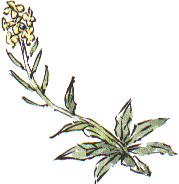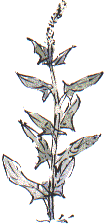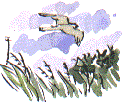Nature Diary
Rocks
History
Gallery
Links
Home Page
  HUNDREDS of Turkey Oak acorns lie beneath the trees in Thornhill Park. The leaves follow the usual oak pattern, but with nearly triangular lobes. The gall wasp that causes the knopper gall has alternate generations. One generation lays its eggs on the acorns of our native oaks, while the next lays its eggs on the catkins of the Turkey Oak.
HUNDREDS of Turkey Oak acorns lie beneath the trees in Thornhill Park. The leaves follow the usual oak pattern, but with nearly triangular lobes. The gall wasp that causes the knopper gall has alternate generations. One generation lays its eggs on the acorns of our native oaks, while the next lays its eggs on the catkins of the Turkey Oak.
The adults that emerge from the knopper galls are all parthogenic females. The eggs that these females lay on the Turkey Oak catkins hatch into a generation that includes both males and females.
 As we walk through the fallen leaves a Red Admiral takes flight.
As we walk through the fallen leaves a Red Admiral takes flight.
 An area planted out with trees that was bull-dozed a month or two ago is now bright with the yellow flowers of Charlock, also called Wild Mustard. This plant was probably introduced to Britain from the Mediterranean as a leaf vegetable.
An area planted out with trees that was bull-dozed a month or two ago is now bright with the yellow flowers of Charlock, also called Wild Mustard. This plant was probably introduced to Britain from the Mediterranean as a leaf vegetable.
 Alongside a lane near Thornhill Farm, piles of cow manure are stored before being spread on the fields. The over-rich soil along the verge is largely colonised by Good-King-Henry, a plant which is thought to have been introduced to this country as a food plant by Bronze Age farmers from southern Europe. It is used like spinach.
Alongside a lane near Thornhill Farm, piles of cow manure are stored before being spread on the fields. The over-rich soil along the verge is largely colonised by Good-King-Henry, a plant which is thought to have been introduced to this country as a food plant by Bronze Age farmers from southern Europe. It is used like spinach.
 A Kestrel flies over a field of Sweet Corn (perhaps grown for the cows at the farm). Sweet Corn, or Maize is a later introduction to this country, the only cereal to have its origins in the Americas.
A Kestrel flies over a field of Sweet Corn (perhaps grown for the cows at the farm). Sweet Corn, or Maize is a later introduction to this country, the only cereal to have its origins in the Americas.

Richard Bell,
wildlife illustrator
E-mail; 'richard@daelnet.co.uk'
Next day
Previous day
Nature Diary
Wild West Yorkshire home page
|

 HUNDREDS of Turkey Oak acorns lie beneath the trees in Thornhill Park. The leaves follow the usual oak pattern, but with nearly triangular lobes. The gall wasp that causes the knopper gall has alternate generations. One generation lays its eggs on the acorns of our native oaks, while the next lays its eggs on the catkins of the Turkey Oak.
HUNDREDS of Turkey Oak acorns lie beneath the trees in Thornhill Park. The leaves follow the usual oak pattern, but with nearly triangular lobes. The gall wasp that causes the knopper gall has alternate generations. One generation lays its eggs on the acorns of our native oaks, while the next lays its eggs on the catkins of the Turkey Oak. As we walk through the fallen leaves a Red Admiral takes flight.
As we walk through the fallen leaves a Red Admiral takes flight. An area planted out with trees that was bull-dozed a month or two ago is now bright with the yellow flowers of Charlock, also called Wild Mustard. This plant was probably introduced to Britain from the Mediterranean as a leaf vegetable.
An area planted out with trees that was bull-dozed a month or two ago is now bright with the yellow flowers of Charlock, also called Wild Mustard. This plant was probably introduced to Britain from the Mediterranean as a leaf vegetable. Alongside a lane near Thornhill Farm, piles of cow manure are stored before being spread on the fields. The over-rich soil along the verge is largely colonised by Good-King-Henry, a plant which is thought to have been introduced to this country as a food plant by Bronze Age farmers from southern Europe. It is used like spinach.
Alongside a lane near Thornhill Farm, piles of cow manure are stored before being spread on the fields. The over-rich soil along the verge is largely colonised by Good-King-Henry, a plant which is thought to have been introduced to this country as a food plant by Bronze Age farmers from southern Europe. It is used like spinach. A Kestrel flies over a field of Sweet Corn (perhaps grown for the cows at the farm). Sweet Corn, or Maize is a later introduction to this country, the only cereal to have its origins in the Americas.
A Kestrel flies over a field of Sweet Corn (perhaps grown for the cows at the farm). Sweet Corn, or Maize is a later introduction to this country, the only cereal to have its origins in the Americas.